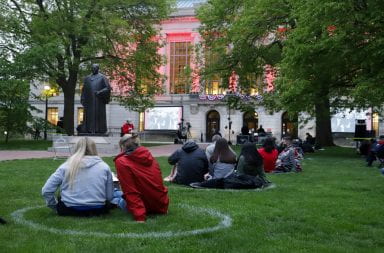While everyone else runs for cover, Tim Samaras confronts tornadoes head-on. For him, narrowly escaping these dangerous storms is just another part of the job.
“There are days, of course, when you chase enough, you run across a situation where a tornado has hit a community only 60 seconds prior,” Samaras said, describing a time when his job took a turn for the worst. “We drove through town, we put science in the back seat and we jumped out and did our best to help the community. We were literally running house to house, looking for survivors.”
Samaras, a National Geographic storm chaser, spoke about his experiences Sunday night in a presentation at the Jeanne B. McCoy Community Center for the Arts in New Albany, Ohio, about 30 minutes from Ohio State’s campus.
The presentation came on the 125th anniversary of the National Geographic Society’s founding. It included photographs and video of Samaras’ field research, which he has conducted since the late 1980s, in Tornado Alley, which is the area of the United States with the most tornadoes on average.
Samaras highlighted the “super outbreak” of April 2011, in which he said more than 330 confirmed tornadoes occurred during a three-day period. That year was the deadliest in U.S. history for tornadoes, according to several sources.
“What I’m trying to do is to help understand why these monsters exist in our atmosphere, why do they get so powerful and why do they even exist in nature,” Samaras said.
Samaras said he hopes to improve the forecasting ability for the storms, which would allow people more time to seek shelter and ultimately save lives.
To achieve this goal, Samaras said he and his team of 12 “chase partners” use weather instruments to collect measurements on tornadoes. Samaras designed one such device, the Hardened In-Situ Tornado Pressure Recorder (HITPR) probe.
Because of its novel design, it manages to stay grounded while tornadoes pass directly overtop, making barometric pressure measurements taken inside the tornado’s core more accurate.
Samaras also spoke about lightning, another storm phenomenon he actively studies. Similar to the probe, he devised his own way of measuring lightning’s processes as it strikes, using specialized cameras to record high-speed images. But unlike tornado season, which occurs April through June, he said lightning is best tracked during monsoon season, from July to September in the United States.
“Almost six months of storm chasing – to me that’s heaven,” Samaras said.
The presentation finished with a 23-minute video of various storms, taking the audience on a virtual ride alongside Samaras and his team.
While the video contained humorous bits, it took on a serious tone as Samaras described an emotional experience in Minnesota where his team visited a community after a storm hit.
Mindy Hayward, director of marketing and communications for the Jeanne B. McCoy Community Center of the Arts, said in an email she hoped audience members would learn “what goes into being a storm chaser, what sort of information they gather when out in the field, and how that information can be beneficial to members of the general public” through Samaras’ presentation.
Bill Yager, 28, attended the presentation with his mother. Yager said he had seen Samaras on television but wanted to hear more about tracking storms.
“I’ve had quite an interest about weather for a while,” Yager said. “So it was real interesting to be able to come and listen to someone and be able to get some answers.”
As for Samaras, his career shows no sign of slowing down.
“We’re about ready to start in for another season,” Samaras told The Lantern. “I’ve got a new instrument on the drawing boards for this coming spring.”


